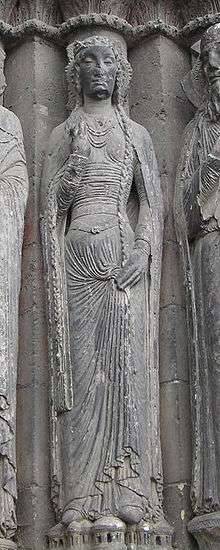bliaut
English

Statue of a woman wearing a bliaut.
Alternative forms
Etymology
From French bliaut, from Old French bliaut, blialt, from Frankish *blīfald, from *blīo + *faldan, from Proto-Germanic *blīwą + *falþaną. Compare also Middle High German blialt (“precious fabric of silk embroidered with gold”), English bleaunt.
Pronunciation
- IPA(key): /ˈbliːˌoʊ/
Noun
bliaut (plural bliauts)
- (historical) A women's overgarment worn in 12th-century Western Europe, featuring voluminous skirts and horizontal puckering or pleating across a snugly fitted underbust abdomen.
French
Etymology
From Middle French bliaut, from Old French bliaut, blialt, from Frankish *blīfald, from *blīo + *faldan, from Proto-Germanic *blīwą + *falþaną. Compare also Old High German blialt (“precious fabric of silk embroidered with gold”), English bleaunt.
Pronunciation
- IPA(key): /bli.jo/
Further reading
- “bliaut” in le Trésor de la langue française informatisé (The Digitized Treasury of the French Language).
Old French
Etymology
From Old French *blīfald, from *blīo + *faldan, from Proto-Germanic *blīwą + *falþaną.
Noun
bliaut m (oblique plural bliauz or bliautz, nominative singular bliauz or bliautz, nominative plural bliaut)
This article is issued from
Wiktionary.
The text is licensed under Creative
Commons - Attribution - Sharealike.
Additional terms may apply for the media files.